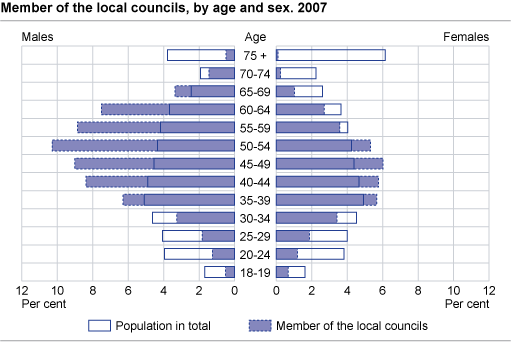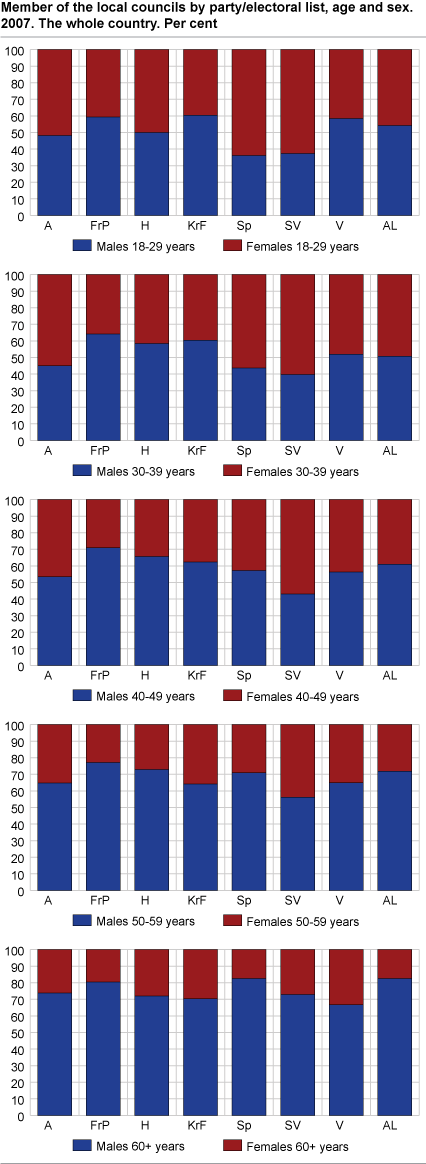Content
Published:
This is an archived release.
More female chairmen
The number of female chairmen rose by 24 to 97 in the 2007 election. 23 per cent of the municipalities now have female chairmen. Close to six out of ten members of municipal councils are between 40 and 59 years of age. The percentage of non-Western immigrants is low, but higher than at the last election.
There is an uneven representation of age groups in municipal councils. The dominating age groups are 40-49 years and 50-59 years, accounting for almost 30 per cent of the representatives each. Men aged 40-59 represent 37 per cent of the elected representative, but 18 per cent of those eligible for election. Women aged 60 and above are underrepresented, as are people below 30 years of age.
Age, gender and party
More than 60 per cent of the representatives below 30 years of age from the Socialist Left Party and the Centre Party are women. In the age group 40-49 years, the Socialist Left Party is the only party where women make up more than half - 57 per cent - of all representatives, whereas in the Progress Party, the proportion of women is only 29 per cent. The proportion of female representatives aged 60 or above is low. It is lowest in the Centre Party with 18 per cent, and highest in the Liberal Party with one third.
Candidates aged 60 years and over, especially females - were not elected
Almost 25 per cent of the candidates were 60 years or older, but only represented 17 per cent of elected representatives. Furthermore, women aged 60 or above represented 9 per cent of all candidates, but only 4 cent of the elected. In the Christian Democratic Party, these women represented 15 per cent of all candidates, but only 5 per cent of the elected. In the Centre Party, they represented 8 per cent of the candidates, but only 2 per cent of the elected.
Three out of four non-Western immigrants from the Labour Party or Socialist Left Party
In total, 223 immigrants were elected, representing 2 per cent of the total number of candidates. This is an increase of 17 representatives since the 2003 election. 83 were immigrants from Western countries (31 fewer than in 2003), while 140 were from non-Western countries (an increase of 48). Three out of four non-Western immigrants represent the Labour Party or Socialist Left Party. The immigrant population constitutes 9 per cent of the population. Non-Western immigrants constitute 6 per cent, while the proportion of non-Western municipality council members is 1.3 per cent.
Immigrant candidates as likely to be elected
The proportion of candidates elected was 17.5 per cent. Among non-Western immigrants and Western immigrants, this figure was 14 per cent and 11 per cent respectively. There are major differences between the parties. From the Labour Party, one in five Western candidates was elected, while one in three non-Western candidates was elected. For four of the other parties, less than 10 per cent of the immigrant candidates were elected.
The Centre Party lost chairmen - the Conservative Party won most new chairmen
The Centre Party lost 23 of its chairmen compared to the 2003 election, but still has the second largest number of chairmen with 83. The Labour Party has the largest number of chairmen with 179. The Conservative Party won 14 new chairmen and now has 77. For the first time, a chairman from the Red Electoral Alliance was elected. The parties in the government alliance now have 62 per cent of the chairmen. 50 chairmen in the municipal council election were chosen directly, an increase of 15 from 2003.
Socialist Left Party lost most deputy chairmen
The Socialist Left Party lost 45 deputy chairmen, a decline from 67 to 22. The Christian Democratic Party and the Labour Party won most deputy chairmen with 17 and 15 respectively.
More female chairmen
The chairmen election resulted in 97 female chairmen. Female chairmen now account for 23 per cent of all chairmen, compared with 17 per cent in the 2003 election. The Labour Party has 51 female chairmen. Compared with the 2003 election, the Labour Party has 18 new female chairmen and the Conservative Party has five.
There was a corresponding increase in the number of female deputy chairmen. As in the 2003 election, there are now twice as many female deputy chairmen as chairmen. More than one third come from the Labour Party.
“One-party municipalities” and various combinations
One in five municipalities has chairmen and deputy chairman from the same party. 62 of these have a chairman and deputy chairman from the Labour Party, while 16 have a chairman and deputy chairman from the Centre Party. 165 municipalities or 38 per cent have a chairman and deputy chairman from the government coalition parties. Similar combinations among the opposition parties are found in 70 municipalities or 16 per cent. In 139 municipalities or 32 per cent, the combinations cross the present borders between government and opposition parties.
Males re-elected
46 per cent of the municipal county members were re-elected. The percentage was 50 for men and 39 for women. Interestingly, the difference in the proportion of re-elected men and women is found among all parties, both the election winners and losers.
3 190 municipal executive board members were also elected, and two of three re-elected members are men. In the county councils, 47 per cent of the members were re-elected.
Tables:
- Table 1 Chairmen, by party and county. 2007
- Table 2 Deputy chairmen, by party and county. 2007
- Table 3 Number of municipalities, by party, chairmen and deputy chairmen. The whole country. 2007
- Table 4 Female chairmen, by party and county. 2007
- Table 5 Female deputy chairmen, by party and county. 2007
- Table 6 Municipalities with direct election of chairman. 2007
- Table 7 Members and re-elected members of the local councils, by county. 2007
- Table 8 Members and re-elected members of the local councils, by sex and party/electoral list. 2007
- Table 9 Chairman and deputy chairman of the county councils. Name and party, by county. 2007
- Table 10 Members and re-elected members of the executive commitee of local councils, by sex and party/electoral lists. 2007
- Table 11 Members of the executive committee of county councils, by party and county. 2007
- Table 12 Members of county councils, by party and county. 2007
- Table 13 Members of the executive committee of the county councils and re-elected members, by county. 2007
- Table 14 Members of the executive committee of local councils, by party and municipality. 2007
- Table 15 Members of the local councils, by party and municipality. 2007
- Table 16 Chairmen/deputy chairmen 2007. Spesification of Joint lists (FL), Local list (LL) and Other lists (AL)
- Table 17 Members and re-elected members, by sex and party/electoral list. 2007
- Table 18 Member of the local councils, by party/electoral list, age and sex. The whole country. 2007. Per Cent
- Table 19 Member of the local councils, by age and sex. The whole country. 2007
- Table 20 Member of the local councils, by age, sex and county. 2007. Per Cent
- Table 21 Member of the county councils, by age and sex. The whole country. 2007
- Table 22 Members of the local councils, by industry, sex and region. 2007. Per Cent
- Table 23 Members of the local councils, by party, industry and sex. 2007. Per Cent
- Table 24 Members of the local councils, by level of occupation, sex and region. 2007
- Table 25 Members of the local councils by, party, level of occupation and sex. 2007. Per Cent
- Table 26 Members of the local councils, by immigration background and region. 2007
- Table 27 Members of the local councils, by immigration background and party. 2007
- Table 28 Members of the local councils, by education, party and sex. 2007
- Table 29 Members of the local councils, by education, sex and region. 2007
- Table 30 Members of the local councils by gross income, sex and region. 2007
- Table 31 Members of the local councils by gross income, sex and party/electoral list. 2007. Per cent
This page has been discontinued, see Municipal and county council election, candidates and representatives, Every four years, candidates.
Find more figures
Find detailed figures from Municipal and county council election, candidates and representatives
Contact
-
Øyvin Kleven
E-mail: oyvin.kleven@ssb.no
tel.: (+47) 45 88 89 37
-
Statistics Norway's Information Centre
E-mail: informasjon@ssb.no
tel.: (+47) 21 09 46 42
-
Tove Bergseteren
E-mail: tove.bergseteren@ssb.no
tel.: (+47) 99 79 08 19


